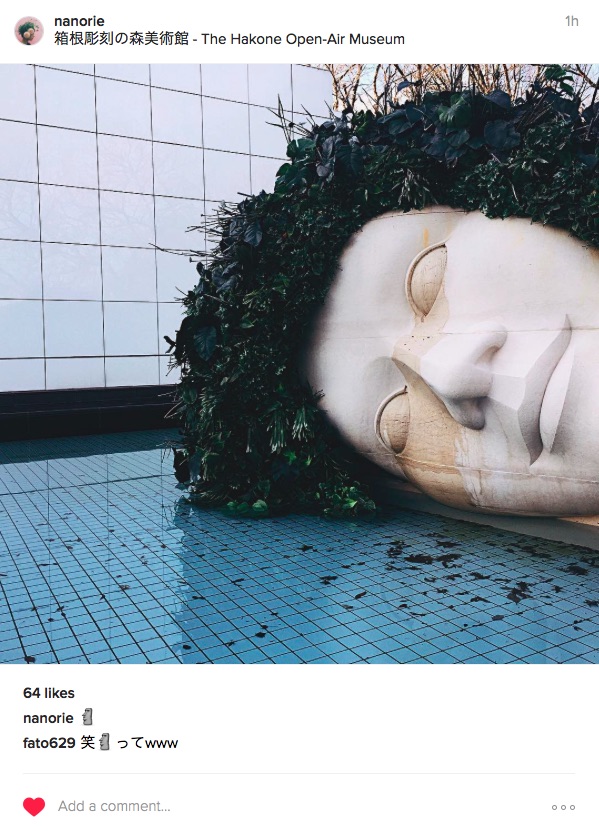Monumental laughing face
« previous post | next post »
From an anonymous reader, who spotted this photograph on Instagram, where it was posted by nanorie, who has given her permission to repost it:
The LL reader says:
[I] was amused by the peculiar blend of communication modes in the comment "笑🗿ってwww".
The meaning is clear enough, but despite its colloquial tone I fail to parse this into any coherent spoken expression, in Japanese or otherwise.
In online parlance, "w" means "warau 笑う ("laugh"), so "www" means something like LOL.
Nathan Hopson gives a more detailed account of "笑🗿ってwww" as a whole:
My best guess at parsing this would be to divide it into three parts:
笑
🗿って
www
So you have a comment that looks like:
That's funny
"A moyai"
Ha ha ha
The commenter is referring to the previous comment, just a single moyai emoji. That is what's funny.
The use of www and its companions of various length as something like "ha ha ha" is an abbreviation of 笑. "Waratta" is a lot to type, I guess? It also resonates with the following smile/laugh kaomoji 顔文字 "face character" (essentially a subspecies of emoji):
(^w^)
Here, the w is the smile itself.
This usage began with online gamers and has spread to the internet and SMS, etc more generally.
Since I was not familiar with 🗿 and didn't know what "moyai" meant, I looked them up on Emojipedia, and this is what I found:
🗿 Moai
A Moyai (also spelled Moai) is a type of human rock carving from Easter Island.
Moyai is also a statue located near Shibuya Station in Tokyo, Japan, which is the likely inspiration for why this is included in the emoji character set. This joins other local landmarks such as the Tokyo Tower and previously Shibuya 109.
Moai was approved as part of Unicode 6.0 in 2010 under the name “Moyai” and added to Emoji 1.0 in 2015.
A parallel to Japanese "www" as an equivalent to "lol" in Chinese is "233". That refers to the 233rd emoticon on a blog named Māopū 猫扑 ("Mop"), which used to be a popular website in China. Here's another website that has both the 233 emoticon and a more detailed explanation for it. Not everybody knows the precise origin of "233", but lots of people know that "233" means hāhāha 哈哈哈 ("hahaha").
As with so many other fields of endeavor, internet language requires considerable xuéwèn 学问 ("learning; erudition; scholarship") to be a true expert. For most people, it's not necessary to possess in-depth knowledge. What's required is sufficient familiarity to be able to use the words one commands in suitable contexts.
[Thanks to Fangdan Li, Tianran Hang, and Jolyon Thomas]

Victor Mair said,
January 14, 2017 @ 12:26 am
From an anonymous correspondent:
According to this website, "w" is an abbreviation of "wara" (笑). Because Chinese characters could not be used in an online game in the 1990s (the site specifically mentions DIABLO, released in 1996), players began using "wara"(笑) and "pupupu"(プププ)in their communication within the game. Around 2002, the usage of multiple "w" became common in 2ch, a famous Japanese online textboard. The number of "w" indicates the degree of one's laughing. (w< www < wwwwww). Recently I often see "草" or variants of "草" such as "草生える" ("to grow grass") to indirectly express "www." This appears to be based on the shape of "w" which looks like grass. I personally dislike this expression (w) and never used it.
krogerfoot said,
January 14, 2017 @ 3:36 am
Hm, I took the second comment to be elaborating on the first, as in:
nanorie: Moyai
fato629: A smiling Moyai LOL
I have the feeling that わらもあい is punning on something having to do with the foliage as hair, or making a reference that nanorie-san is going to get, but I can't figure out what. The second commenter seems amused that first one saw this smiling face with a head full of unruly hair and recalled the famously unsmiling, bald Easter Island statues. That's my guess, anyway.
krogerfoot said,
January 14, 2017 @ 3:47 am
I see that the original conversation is continuing:
nanorie@fato629 ちょっと似てるでしょ w ("It kinda looks like it, doesn't it LOL")
fato629@nanorie 肌感が?www ("The skin tone, you mean? LOL")
肌感覚 is more like "the way skin feels to the touch" as in smooth, rough, dry, etc.
Jerry Friedman said,
January 14, 2017 @ 9:54 am
krogerfoot: The skin texture?
Paul said,
January 14, 2017 @ 4:11 pm
My thought on reading it was that the moai was standing in for 顔 in 笑顔 (smile, smiling face).
Krogerfoot said,
January 14, 2017 @ 6:28 pm
I endorse the previous two comments (@Paul and @Jerry Friedman).
Michael Watts said,
January 15, 2017 @ 12:00 am
233 also permits repetitive emphasis; "23333" is common. The other Chinese method of typing laughter is hhhhhh (as many as you feel are warranted, generally a lot); as I understand it, the h's just represent 哈characters, because that's the convenient way to produce a string of 哈 with pinyin input.
AG said,
January 15, 2017 @ 7:12 pm
And "5" is "ha" in Thai, so "555" is the Thai version of this stuff.
Alyssa said,
January 16, 2017 @ 3:04 pm
Krogerfoot: The って makes it hard for me to read it that way – if it were 笑www alone I think it would make sense as "a smiling moai LOL". But my Japanese is far from fluent so I don't know if my intuition counts for much.
krogerfoot said,
January 16, 2017 @ 8:35 pm
Alyssa: I'm betting everything on Paul's interpretation being the correct one.